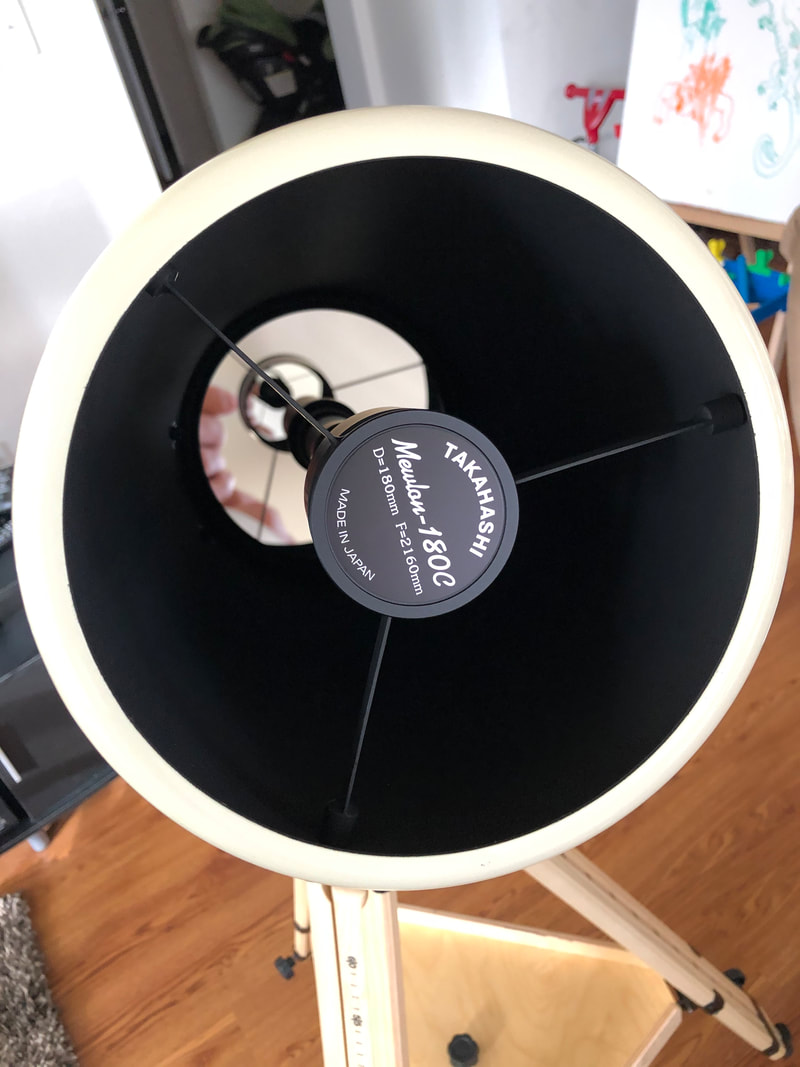|
So I may have contracted a mild case of aperture fever. Not the first time, and likely not the last. I caught a glimpse of the Ring Nebula with my 100mm Takahashi recently, and part of me was impressed. With averted vision I could just make out a ghostly grey smoke ring - not bad, considering the bright urban sky. Yet the view made me wonder what it might look like through something bigger; viewing the moon made me wish for even higher magnifications and just a bit more light. I like my C8, but its optical quality isn't quite on par with that of my fine refractors. And while it cools down in 40 minutes or so if the weather is mild, that won't cut it in the winter. So, I bought a Takahashi Mewlon 180. It turned out that I had a lot more money squirreled away in my university accounts than I expected, and I can only spend it on research or research-related equipment. That meant telescopes, and the Mewlon, I felt, would fulfill all my needs. It squeezes a lot of aperture into a package that's almost as small as a Catadioptric, except it's a Dall-Kirkham reflector, which means it doesn't have a corrector at the front and therefore cools down quite quickly. It's also a Takahashi, and that all but guarantees excellent optical quality and superior craftsmanship. I was tempted to get the (even) pricier 210mm version, but after a lot of reading I decided on something just a bit smaller: something that would cool down even faster and be less sensitive to poor atmospheric seeing. When you take it out of the box(es), the Mewlon does not disappoint. It's the most beautiful telescope I've ever owned. It looks like a jet engine. It's a bit bigger than I expected - of course - but light and wonderfully well-balanced around its slender dovetail. I got a giant and excessively well-added carrying bag for it, which adds significantly to the hassle of lugging it to my observing sites but adds a little peace of mind, too. Within a week of the Mewlon's arrival, the sky was clear and the Moon a beautiful crescent. I carried both the Mewlon and my TV 85 to our observation deck. It was cold, and I used the TeleVue for about 35 minutes while the Mewlon cooled. Once again, the little telescope surprised me. It seems to defy the laws of physics by squeezing so much performance out of such a tiny package. Details on the Moon were simply stunning, and Saturn - despite being low on the horizon, and despite some very mediocre seeing - wasn't bad either. Two things were immediately obvious when I switched to the Mewlon: first, the view was brighter and I could use a lot more magnification, although the Moon was now lower on the horizon and the seeing was worse. Second, my little Berlebach Report tripod and VAMO Traveller mount just couldn't handle the Mewlon like they could the shorter - but slightly wider - C8. The view wobbled, badly. I've already ordered a sturdier tripod (another from Berlebach) and tripod (this time from Stellarvue). Still, I was delighted with the Mewlon. The Moon's terminator was just a bit more detailed, even at relatively low magnifications, than it had been through the TV 85. The view wasn't completely different at those magnifications - a testament to the much smaller TV 85 - but there was definitely more there, and it was crisper than it had been through the C8. At high magnifications - magnifications the TV 85 couldn't match - a new world started to emerge. I don't think the Mewlon had fully cooled down, however, despite the wait, and I wish I could have stayed out just a bit longer. Whenever the Moon is up, I try to take pictures using my iPhone 8. That's as close to astrophotography as I hope to get, at least for now. Although iPhone pictures inevitably have far less clarity, vibrance, and sharpness than views through the eyepiece, I am learning how to take better shots. I've given up on the gadgets that some telescope makers sell to mount the phone in front of the eyepiece; in my experience, the results are too often disappointing. Instead, I've learned to hold my hands more steadily - steadily enough to focus the phone on the object I'm observing. I've also learned to enhance the clarity and definition of the photos I take, and then slightly increase the settings for shadows, vibrance, and occasionally black point to better approximate what I'm seeing. My most important lesson, however, is to take videos of anything other than zoomed out views of the Moon. By taking videos, I can freeze on frames in which atmospheric seeing suddenly stabilizes. When I take a screenshot of those frames, the resulting picture is often much sharper than I get by just starting on picture mode. Some objects that are totally washed out otherwise - like Saturn - start to look like themselves when I take a video. I enjoy taking even the decidedly amateurish photos I can get with my iPhone. But at some point, I'd like to try my hand at sketching, like the nineteenth-century observers I've been reading and writing about lately. I doubt my results will equal theirs at first, but it will be fun to try.
1 Comment
Rachel
1/20/2022 01:53:20 pm
You took this photo the night my daughter was born. Do you mind if I save the photo of the moon?
Reply
Leave a Reply. |
Archives
March 2024
Categories
All
|












 RSS Feed
RSS Feed